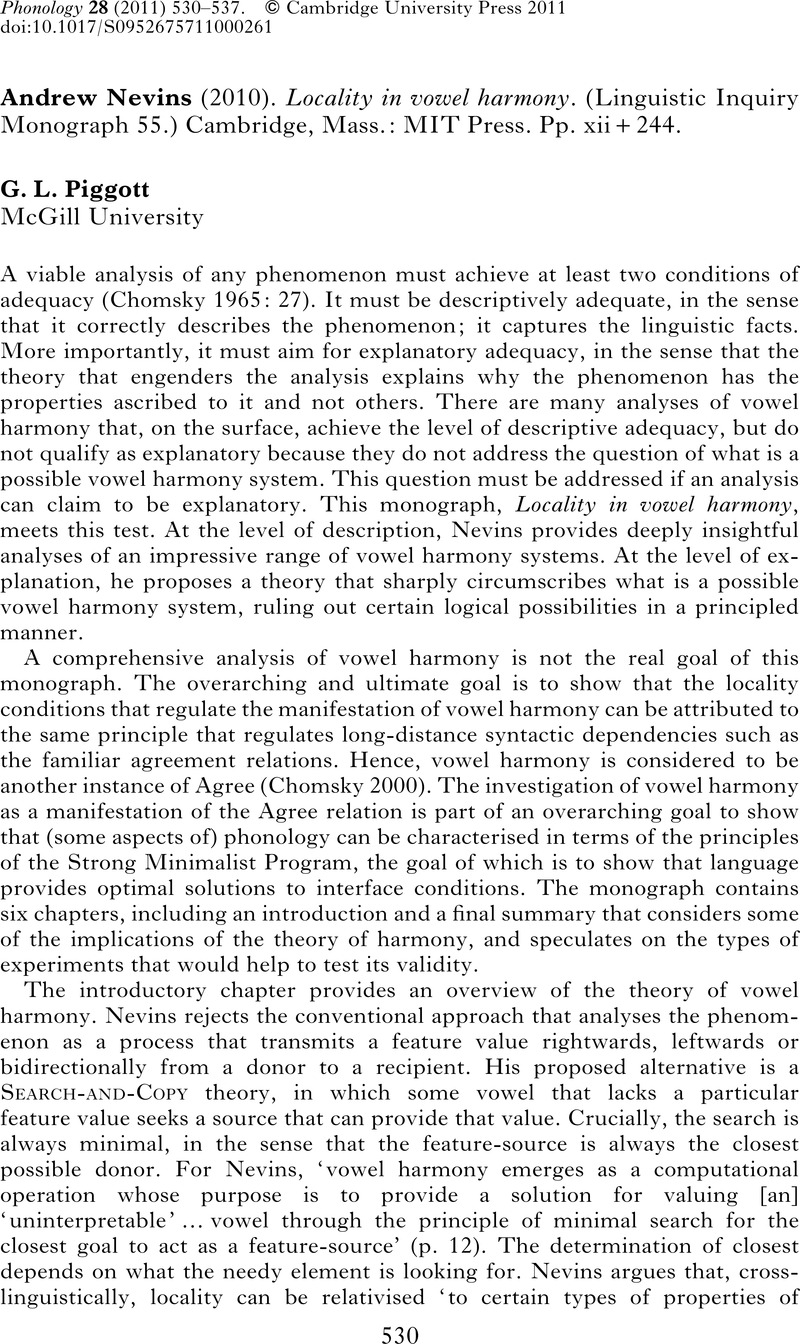No CrossRef data available.
Article contents
Andrew Nevins (2010). Locality in vowel harmony. (Linguistic Inquiry Monograph 55.) Cambridge, Mass.:MIT Press. Pp. xii+244.
Published online by Cambridge University Press: 08 December 2011
Abstract
An abstract is not available for this content so a preview has been provided. Please use the Get access link above for information on how to access this content.

- Type
- Book Review
- Information
- Copyright
- Copyright © Cambridge University Press 2011
References
REFERENCES
Baković, Eric (2000). Harmony, dominance, and control. PhD dissertation, Rutgers University.Google Scholar
Beckman, Jill N. (1997). Positional faithfulness, positional neutralisation and Shona vowel harmony. Phonology 14. 1–46.CrossRefGoogle Scholar
Beckman, Jill N. (1998). Positional faithfulness. PhD dissertation, University of Massachusetts, Amherst.Google Scholar
Bobaljik, Jonathan David (2008). Where's phi? Agreement as a postsyntactic operation. In Harbour, Daniel, Adger, David & Béjar, Susana (eds.) Phi theory: phi-features across modules and interfaces. Oxford: Oxford University Press. 295–328.CrossRefGoogle Scholar
Charette, Monik (1991). Conditions on phonological government. Cambridge: Cambridge University Press.CrossRefGoogle Scholar
Chomsky, Noam (2000). Minimalist inquiries: the framework. In Martin, Roger, Michaels, David & Uriagereka, Juan (eds.) Step by step: essays on minimalist syntax in honor of Howard Lasnik. Cambridge, Mass.: MIT Press. 89–155.Google Scholar
Dresher, B. Elan (2009). The contrastive hierarchy in phonology. Cambridge: Cambridge University Press.CrossRefGoogle Scholar
Embick, David (2010). Localism versus globalism in morphology and phonology. Cambridge, Mass.: MIT Press.Google Scholar
Gafos, Adamantios (1996). The articulatory basis of locality in phonology. PhD dissertation, Johns Hopkins University.Google Scholar
Goldsmith, John (1976). An overview of autosegmental phonology. Linguistic Analysis 2. 23–68.Google Scholar
Hansson, Gunnar Ólafur (2001). Theoretical and typological issues in consonant harmony. PhD dissertation, University of California, Berkeley.Google Scholar
Kaye, Jonathan, Lowenstamm, Jean & Vergnaud, Jean-Roger (1985). The internal structure of phonological representations: a theory of charm and government. Phonology Yearbook 2. 305–238.CrossRefGoogle Scholar
Krämer, Martin (2003). Vowel harmony and Correspondence Theory. Berlin & New York: Mouton de Gruyter.CrossRefGoogle Scholar
Mailhot, Frédéric & Reiss, Charles (2007). Computing long-distance dependencies in vowel harmony. Biolinguistics 1. 28–48.CrossRefGoogle Scholar
Piggott, G. L. (1992). Variability in feature dependency: the case of nasal harmony. NLLT 10. 33–77.Google Scholar
Piggott, G. L. (2003). Theoretical implications of segment neutrality in nasal harmony. Phonology 20. 375–424.CrossRefGoogle Scholar
Walker, Rachel (1998). Nasalization, neutral segments and opacity effects. PhD dissertation, University of California, Santa Cruz.Google Scholar




